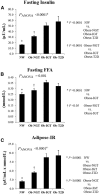Adipose Tissue Insulin Resistance in Youth on the Spectrum From Normal Weight to Obese and From Normal Glucose Tolerance to Impaired Glucose Tolerance to Type 2 Diabetes
- PMID: 30455334
- PMCID: PMC6341282
- DOI: 10.2337/dc18-1178
Adipose Tissue Insulin Resistance in Youth on the Spectrum From Normal Weight to Obese and From Normal Glucose Tolerance to Impaired Glucose Tolerance to Type 2 Diabetes
Abstract
Objective: Adipose tissue insulin resistance is one of the pathophysiological components of type 2 diabetes. Herein we investigated: 1) adipose insulin resistance index (Adipose-IR) (calculated as fasting insulin × free fatty acids [FFAs]) in youth across the spectrum of adiposity from normal weight to obese and the spectrum from normal glucose tolerance (NGT) to impaired glucose tolerance (IGT) to type 2 diabetes, 2) the relationship of Adipose-IR with physical and metabolic characteristics, and 3) the predictive power of Adipose-IR for determining dysglycemia in youth.
Research design and methods: A total of 205 youth had fasting glucose, insulin, FFA, Adipose-IR, body composition, visceral adipose tissue (VAT), leptin, and adiponectin evaluated.
Results: Adipose-IR was 2.2-fold higher in obese NGT, 4.3-fold higher in IGT, and 4.6-fold higher in type 2 diabetes compared with that in normal-weight peers (all P < 0.05). Females with dysglycemia (IGT and type 2 diabetes) had higher Adipose-IR than their male counterparts (P < 0.001). Adipose-IR correlated positively with total body and visceral adiposity, fasting glucose, HOMA-IR, and leptin and negatively with adiponectin. Receiver operating characteristic curve analysis yielded an optimal cutoff for Adipose-IR of 9.3 μU/mL × mmol/L for determining dysglycemia with 80% predictive power.
Conclusions: Adipose-IR is a simple surrogate estimate that reflects pathophysiological alterations in adipose tissue insulin sensitivity in youth, with progressive deterioration from normal weight to obese and from NGT to IGT to type 2 diabetes. Adipose-IR can be applied in large-scale epidemiological/observational studies of the natural history of youth-onset type 2 diabetes and its progression or reversal with intervention strategies.
© 2018 by the American Diabetes Association.
Figures
Similar articles
-
Role of Adipose Tissue Insulin Resistance in the Natural History of Type 2 Diabetes: Results From the San Antonio Metabolism Study.Diabetes. 2017 Apr;66(4):815-822. doi: 10.2337/db16-1167. Epub 2017 Jan 4. Diabetes. 2017. PMID: 28052966
-
Insulin sensitivity across the lifespan from obese adolescents to obese adults with impaired glucose tolerance: Who is worse off?Pediatr Diabetes. 2018 Mar;19(2):205-211. doi: 10.1111/pedi.12562. Epub 2017 Jul 20. Pediatr Diabetes. 2018. PMID: 28726334
-
Adipose Insulin Resistance in Obese Adolescents Across the Spectrum of Glucose Tolerance.J Clin Endocrinol Metab. 2016 Jun;101(6):2423-31. doi: 10.1210/jc.2016-1376. Epub 2016 Apr 7. J Clin Endocrinol Metab. 2016. PMID: 27054297 Free PMC article.
-
Studying progression from glucose intolerance to type 2 diabetes in obese children.Diabetes Metab Syndr. 2014 Jul-Sep;8(3):133-7. doi: 10.1016/j.dsx.2014.07.002. Epub 2014 Aug 7. Diabetes Metab Syndr. 2014. PMID: 25127329 Review.
-
Pathophysiology of type 2 diabetes mellitus in youth: the evolving chameleon.Arq Bras Endocrinol Metabol. 2009 Mar;53(2):165-74. doi: 10.1590/s0004-27302009000200008. Arq Bras Endocrinol Metabol. 2009. PMID: 19466209 Free PMC article. Review.
Cited by
-
Hyperinsulinemia and insulin resistance in the obese may develop as part of a homeostatic response to elevated free fatty acids: A mechanistic case-control and a population-based cohort study.EBioMedicine. 2021 Mar;65:103264. doi: 10.1016/j.ebiom.2021.103264. Epub 2021 Mar 9. EBioMedicine. 2021. PMID: 33712379 Free PMC article.
-
Adipose Tissue Insulin Resistance is Closely Associated with Metabolic Syndrome in Northern Chinese Populations.Diabetes Metab Syndr Obes. 2021 Mar 12;14:1117-1128. doi: 10.2147/DMSO.S291350. eCollection 2021. Diabetes Metab Syndr Obes. 2021. PMID: 33737823 Free PMC article.
-
An update of the consensus statement on insulin resistance in children 2010.Front Endocrinol (Lausanne). 2022 Nov 16;13:1061524. doi: 10.3389/fendo.2022.1061524. eCollection 2022. Front Endocrinol (Lausanne). 2022. PMID: 36465645 Free PMC article. Review.
-
The Role of Childhood Obesity in Early-Onset Type 2 Diabetes Mellitus: A Scoping Review.Cureus. 2023 Oct 31;15(10):e48037. doi: 10.7759/cureus.48037. eCollection 2023 Oct. Cureus. 2023. PMID: 38034219 Free PMC article.
-
Indicators of insulin resistance in clinical practice.Hypertens Res. 2024 Apr;47(4):978-980. doi: 10.1038/s41440-023-01566-7. Epub 2024 Jan 4. Hypertens Res. 2024. PMID: 38177290 No abstract available.
References
Publication types
MeSH terms
Substances
Grants and funding
LinkOut - more resources
Full Text Sources
Medical


